Agglomeration (particle size enlargement) is widely used throughout the agriculture industry to minimize dust, improve handling and transportation characteristics, and enhance product performance – among other things. The practice offers benefits to everything from fertilizers and soil amendments, to animal feed products, and even pesticides.
Below is an overview on how agglomeration equipment is employed to produce a premium product, as well as the advantages this diverse practice brings to the industry.
Note: While a few different types of agglomeration exist, this article refers exclusively to tumble-growth/non-pressure agglomeration, also known as pelletizing, agitation agglomeration, or wet granulation.
Why Agglomerate Ag Materials
Agglomeration offers numerous benefits in any application, many of which are the basis for its prolific use in agriculture. The benefits that can be achieved are largely dependent on the material and application, but often include:
Handling Benefits:
- Segregation prevention when working with blends and complex fertilizers
- Greater flowability of product through feed bins, hoppers, transfer points, and the like
- Enhanced metering and dosing of product
- Significantly reduced dust
End Product Use Benefits:
- Improved end product appearance and performance (slow-release capabilities, improved active ingredient delivery, etc.), resulting in a premium product
- More accurate and predictable application on fields due to material not becoming wind blown
- Reduced caking during storage
- Mitigation of dust during handling and use
Economic Benefits:
- More complete utilization of raw materials
- Reduced loss of product to dust
- Improved opportunity for use (manure, compost, etc.)
- Better transportation economics (fewer transport units required in some cases)
Product Customization
In addition to these benefits, agglomeration also allows producers to precisely control the end product’s physical specifications, which in turn lets them control factors such as appearance and performance. This high level of control is especially important in the production of fertilizers and soil amendments, as producers must meet exacting parameters for products to measure up to claims and perform as desired. Target parameters for ag products often include:
- Crush strength
- Bulk density
- Particle shape
- Attrition
- Hygroscopicity
- Solubility
- Moisture content
Top Applications for Agglomeration in Agriculture
The agriculture industry works with a range of different materials that benefit from agglomeration:
Fertilizers
Agglomeration has become a fairly standard practice when producing fertilizers as a result of the improved handling, application, and performance characteristics the approach can lend.
Agglomeration can be used with both single-nutrient products, as well as complex multi-nutrient fertilizers. Commonly pelletized fertilizers include:
- Ammonium sulfate
- Ammonium nitrate
- Boron
- Potash (MOP, SOP, SOPM)
- Ammoniated Phosphates (MAP, DAP)
- Superphosphates (SSP, TSP)
- Urea
- NPK
- Sulfur
- Manure and biosolids
- Magnesium
- Zinc
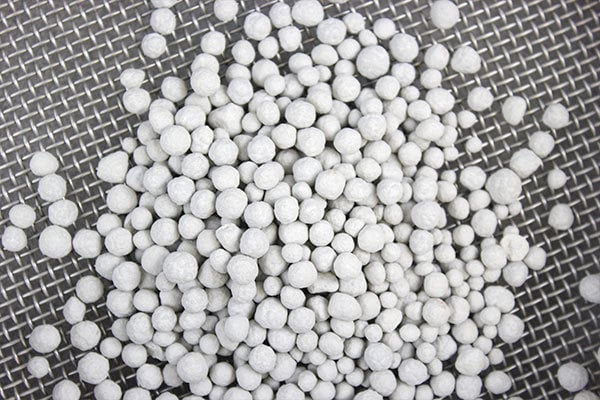
Pelletized MAP fertilizer produced in the FEECO Innovation Center
Soil Amendments
Similarly, soil amendments are also commonly agglomerated as a way of managing handling and application qualities. With both fertilizers and soil amendments, the agglomeration process allows for inclusion of beneficial additives and a high level of formulation customization. Common soil amendment applications include:
- Limestone
- Gypsum (natural an synthetic)
- Calcium
- Iron
- Humate
- Bone meal
- Blood meal
- Feather meal
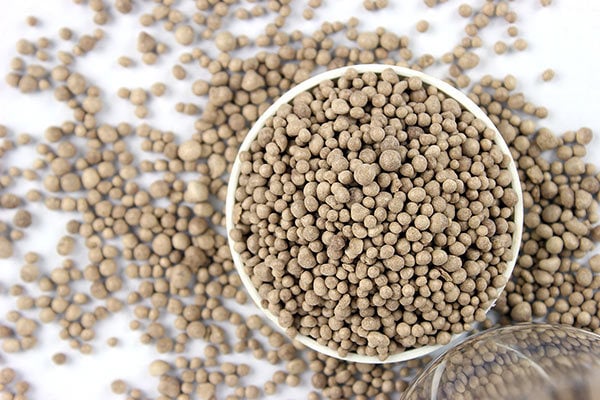
Pelletized gypsum soil amendment produced in the FEECO Innovation Center
Animal Feed & Feed Supplements
Animal feeds and feed supplements are also widely agglomerated. This might be to improve palatability, enhance digestibility, or just make the feed easier to work with and promote a cleaner production environment. This often includes:
- Phosphates (MCP, DCP, DFP)
- Milk
- Egg Powder
- Calcium Carbonate
- Potassium
- Bone Meal
- Blood Meal
- Feather Meal
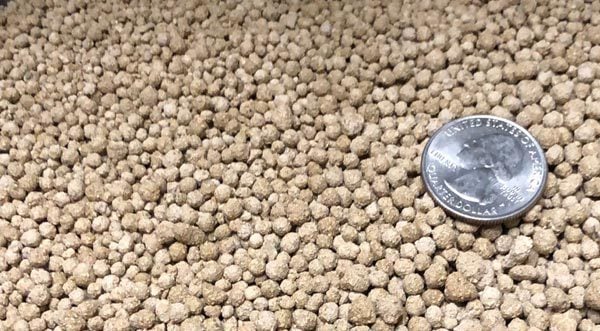
Pelletized bone meal produced in the FEECO Innovation Center
Herbicides & Pesticides
Herbicides and pesticides are agglomerated for many of the same reasons that fertilizers and soil amendments are. The potential for contaminating surrounding areas, however, makes application accuracy and minimal dust especially important, making agglomeration even more critical.
Common Agglomeration Equipment Used in Agriculture
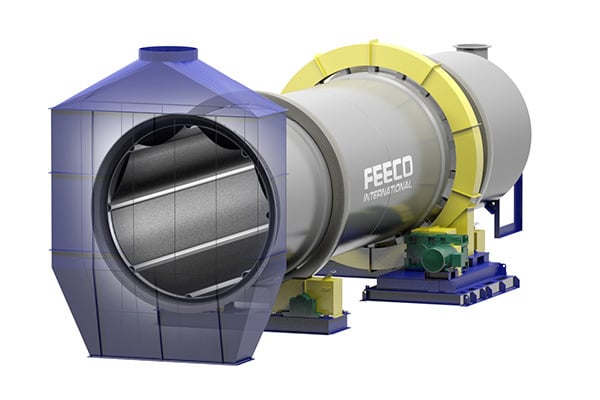
3D Model of a FEECO Granulation Drum
Rotary Drums
Rotary drums are used prolifically throughout the agriculture industry, accomplishing everything from conditioning, to granulation and coating. They also serve as the basis for drying and cooling equipment. Rotary drums engineered for agglomeration applications include:
Granulation Drums
Granulation drums, also commonly referred to as granulators, are the industry standard for many agricultural applications, particularly when it comes to fertilizer production. They are highly customizable, and offer high-capacity processing. They are also the device of choice for carrying out agglomeration processes that employ a chemical reaction, such as the production of NPK fertilizer.
Coating Drums
Coating drums are also used extensively throughout agriculture. Their uniform agglomerate coating capability provides superior results and offers opportunity for controlled-release properties, inclusion of beneficial additives, and better handling properties.
Conditioning Drums
The term “conditioning drum” is applied to several applications in agriculture. These drums are frequently used for mixing materials, as well as promoting rough agglomeration. They are often used in potash production lines to condition or “polish” granules produced via roll compaction (a type of pressure agglomeration used to produce some fertilizers). Granules produced via roll compaction are jagged and irregular; running them through a conditioning or polishing drum breaks off loose edges to reduce the potential for dust generation (attrition) during later handling.
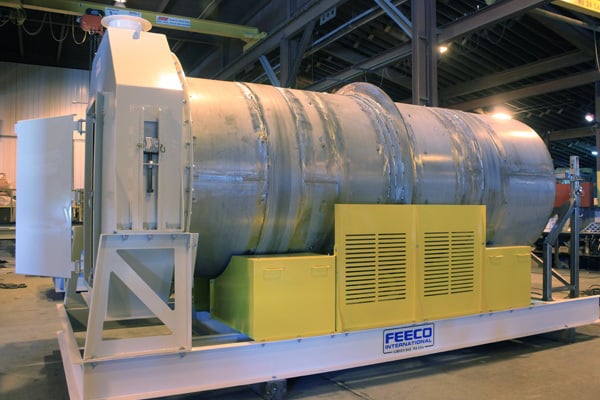
FEECO Coating Drum
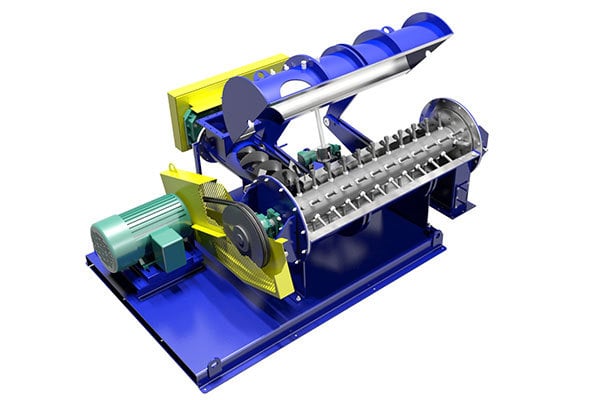
3D Model of a FEECO Pin Mixer
Pin Mixers
The pin mixer is a type of horizontal, continuous mixer applied to a range of products and objectives in agriculture.
The mixer seamlessly combines ultra-fine powder(s) with a liquid binder to produce a homogeneous mixture. The mixer’s intense spinning action densifies material and is capable of forming small agglomerates (subsequently, this process is often referred to as micro pelletizing).
The pin mixer is often paired with a disc pelletizer, serving as a preconditioning step to provide the pelletizer with a uniform feedstock or seed pellets. The pairing of these two devices produces a highly refined, round granule.

FEECO Pin Mixer
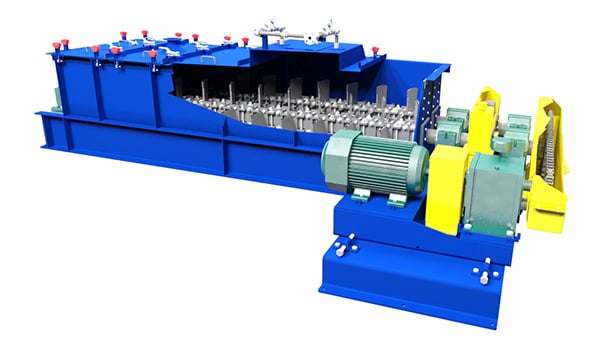
3D Model of a FEECO Pugmill Mixer
Pugmill Mixers (aka Pug Mills or Paddle Mixers)
Pugmill mixers, also known as pug mills or paddle mixers, lend diverse processing capabilities to the agriculture industry.
Also a horizontal, continuous-type mixer, the pugmill mixer shares some functionality with the pin mixer, chiefly in that it can homogeneously combine liquid and solid feedstocks. This type of mixer, however, uses a more gentle kneading action on material and is therefore more suitable for applications processing materials that are in a sludge-like form, are highly abrasive, or that consist of larger particles and lumps. It also utilizes a longer retention time, which is helpful when a chemical reaction will occur.
Pugmill mixers are often used as a conditioning device in order to de-dust material and form rough agglomerates.
Pugmill mixers are also widely employed as a back-mixing device; dried product is mixed in the pugmill with wet feedstock to bring down the overall moisture content of the feedstock going into the process.
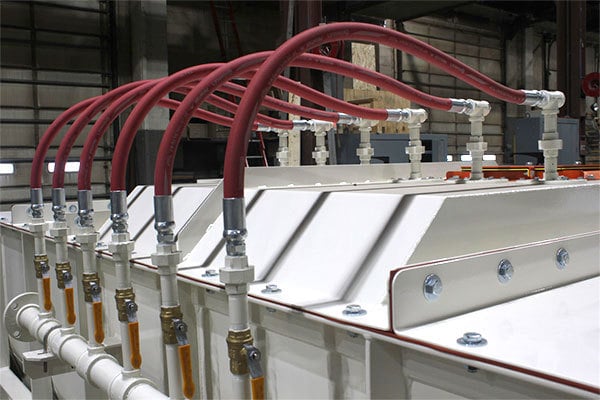
FEECO Pugmill Mixer with custom spray system
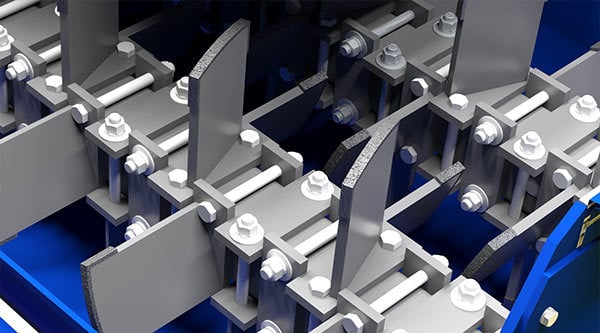
3D image of the pugmill mixer’s interior twin shafts fitted with paddles
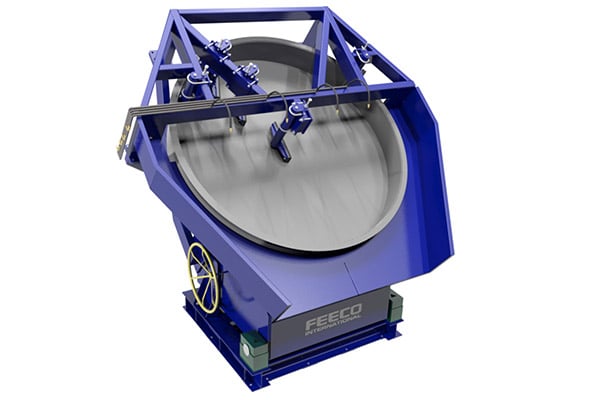
3D Model of a FEECO Disc Pelletizer (Pan Granulator)
Disc Pelletizers (Pan Granulators)
Disc pelletizers, or pan granulators, are used when a more round granule is desired and particle size distribution must be narrow. As mentioned, disc pelletizers are often paired with pin mixers in order to produce a refined pellet product.
Disc pelletizers use a rotational tumbling motion and a liquid binder to form agglomerates.
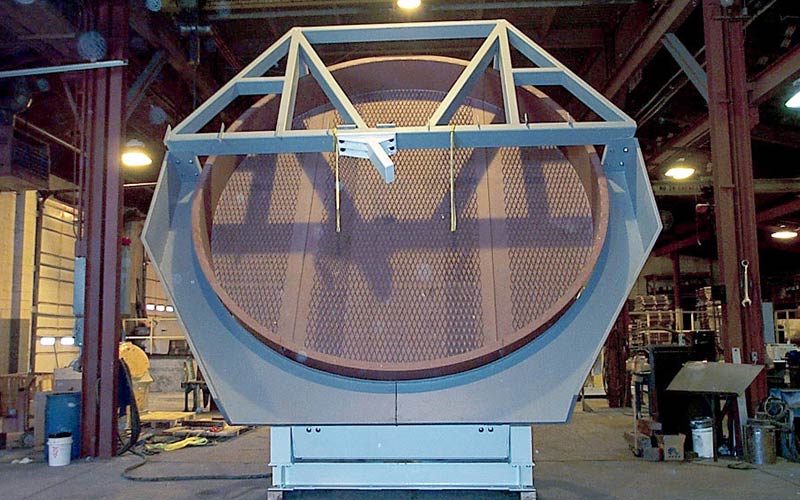
Choosing the Right Agglomeration Equipment for the Application
The agglomeration process is incredibly flexible and diverse. The equipment configuration is a matter of balancing process parameters such as feed rates, retention time, and more, with the raw material’s characteristics in order to produce the desired end product. When multiple approaches may serve the purpose, or aspects of the process are unclear, the best approach is often determined through testing in a facility such as the FEECO Innovation Center.
Testing fertilizers, soil amendments, and animal feed in such a facility allows producers to evaluate multiple pieces of equipment and process configurations, as well as identify and refine process parameters to efficiently achieve the desired results.
Conclusion
Agglomeration plays an essential role in the agriculture industry. Whether working with fertilizers and soil amendments, animal feed products or pest management, tumble-growth agglomeration yields a product with benefits ranging from improved handling and application, to better transportation economics, and much more.
FEECO is the world’s foremost provider of tumble-growth agglomeration equipment and complete process systems. All FEECO agglomeration equipment is engineered around the specific qualities of the material to be processed, as well as the customer’s target objectives for the process. Equipment can be tested and processes developed in our Innovation Center, where we are able to confirm proof of process and proof of product. For more information on our agglomeration capabilities, contact us today!

